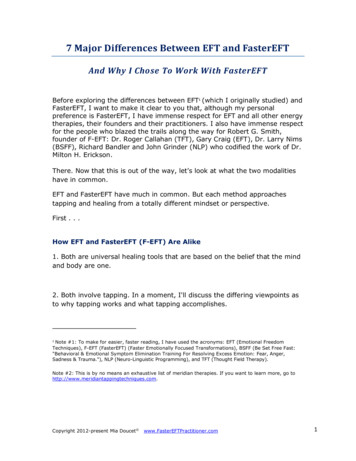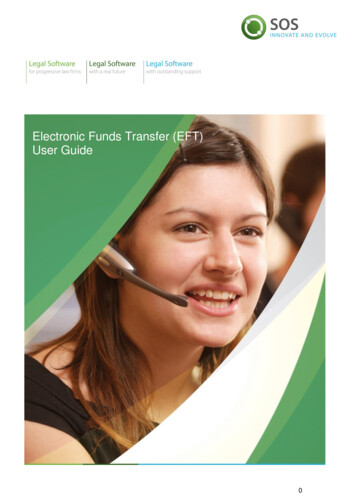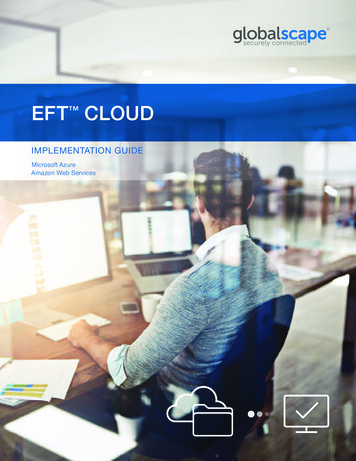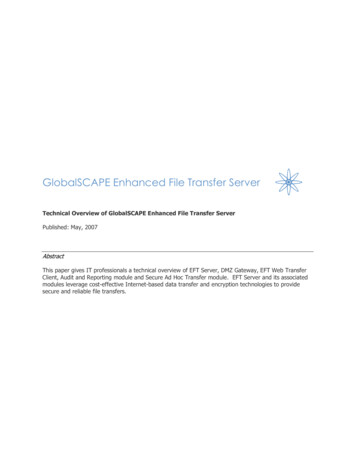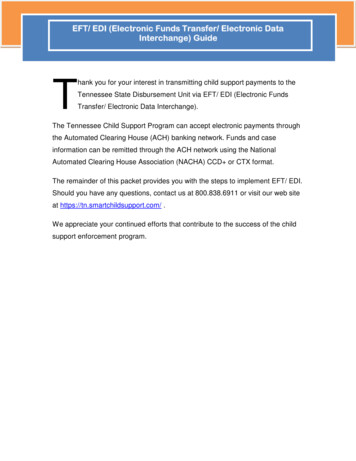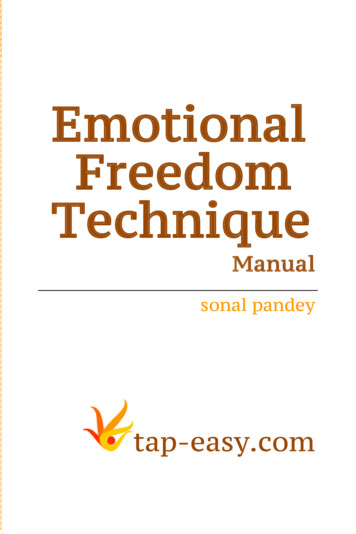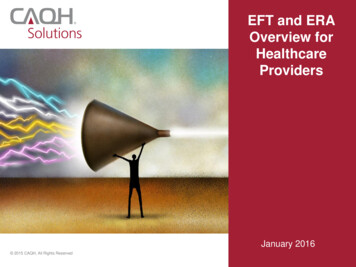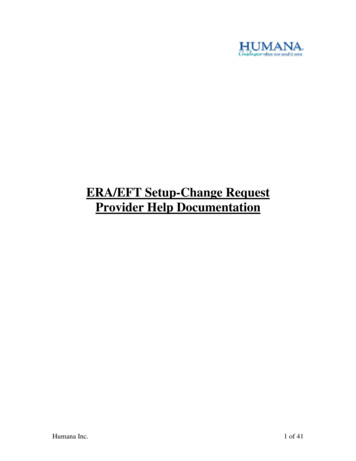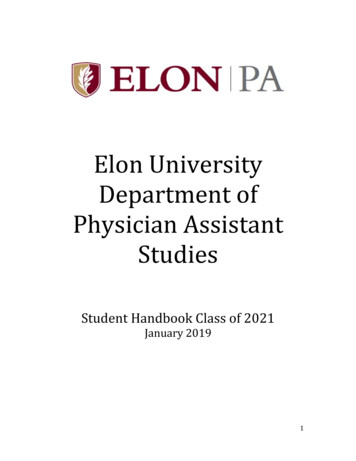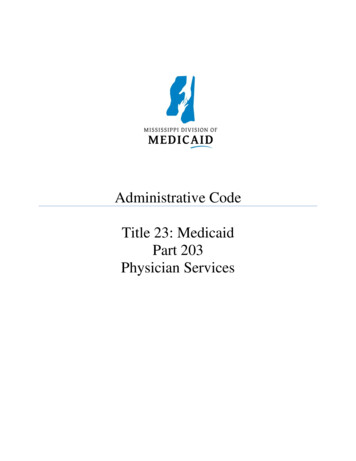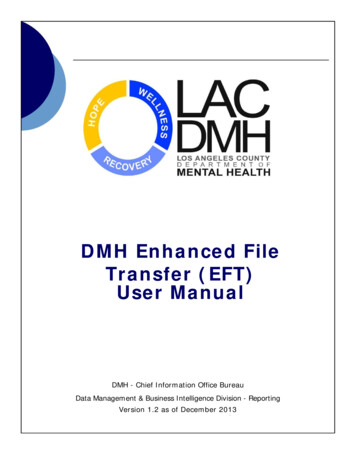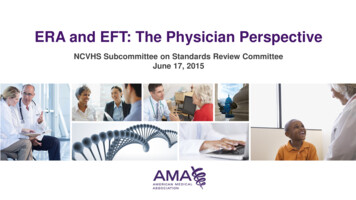
Transcription
ERA and EFT: The Physician PerspectiveNCVHS Subcommittee on Standards Review CommitteeJune 17, 2015
Electronic Remittance Advice (ERA): Provider Benefits Faster payment processing time Reduced time spent on manual processes (e.g., openingenvelopes, filing)– Frees up resources for patient care Standardization yields improved understanding ofclaims adjustments Enhanced reconciliation potential 2015 American Medical Association. All rights reserved.2
Current State of ERA Adoption 2014 CAQH Index reports moderate rate ofERA adoption1:– 55% health plans– 47% providers– 51% health plans and providers combined Increased adoption could yield approximately 1.5 billion incurrently untapped savings for the industry11. 2014 CAQH Index Electronic Administrative Transaction Adoption and Savings Calendar Year 2013. Available at:http://www.caqh.org/pdf/2014Index.pdf. 2015 American Medical Association. All rights reserved.3
Barriers to Physician ERA Adoption Enrollment challenges (separate process for eachhealth plan) Inefficient reconciliation with electronic funds transfer(EFT) payments Health plan noncompliance with standards andoperating rules 2015 American Medical Association. All rights reserved.4
ERA Reconciliation Concerns ERA and standard EFT are designed to work synergistically to maximize paymentautomation and reconciliation Standard EFT payments are made using the CCD addenda format, whichcontains necessary information for pairing EFT with ERA Many vendors do not support automated reconciliation, driving practice staff backto manual processes Some banks are truncating the reassociation trace number (TRN) Reconciliation challenges highlighted in recent ADA/AMA/MGMA informal Websurvey comments– “It is easier to receive payments by check so that the EOB is included with the check.”– “We want receipt of a paper check for documentation purposes.” 2015 American Medical Association. All rights reserved.5
ERA Compliance Issues Some health plans still will not provide ERA upon physician request Many ERAs do not properly balance, requiring additional work for practices Health plan portals provide more complete/accurate remittance informationthan standard transaction; incentive to use portal vs. ERA Health plans not following required ERA/EFT 1:1 ratio (1 ERA 1 EFT) Improper use of Claim Adjustment Reason Codes (CARCs), RemittanceAdvice Remark Codes (RARCs), and code combinations– Example: Use of CARC 45 (“charge exceeds fee schedule/maximum allowable orcontracted/legislated fee arrangement”) as a default “catch-all” code when there isa more accurate message to send physicians 2015 American Medical Association. All rights reserved.6
Recommendations Additional operating rules to improve quality of information in ERA– Provide guidance on use of Alert RARCs for specific scenarios (e.g., reversals)– Prohibit use of “dummy” codes to force ERA balancing– Expand CARC/RARC compliance to include not just use of valid codes, butconveyance of accurate message– Require health plans to regenerate ERAs upon provider request (i.e., after receiptof noncompliant ERA) Increased compliance enforcement is essential– Providers fearful to “bite the hand that feeds” and report noncompliance issues– Practices may not reject noncompliant ERA because they need the funds– Assurance of ERA quality will encourage increased provider adoption 2015 American Medical Association. All rights reserved.7
Automated Clearing House EFT (ACH EFT):Provider Benefits Reduced time spent on manual processes (e.g. openingenvelopes, internally processing checks, taking checks to bank)– Frees up resources for patient care Reduced risk of fraud Faster receipt of payments Elimination of lost checks/check stubs Enhanced reconciliation potential 2015 American Medical Association. All rights reserved.8
Current State of ACH-EFT Adoption ADA/AMA/MGMA survey showed that 80% of providers arereceiving ACH EFT from at least some health plans 2014 CAQH Index reports moderate rate of overallACH-EFT adoption1:– 58% for both health plans and providers Improved ACH-EFT adoption could save the industryapproximately 740 million in currently untapped savings11. 2014 CAQH Index Electronic Administrative Transaction Adoption and Savings Calendar Year 2013. Available at:http://www.caqh.org/pdf/2014Index.pdf. 2015 American Medical Association. All rights reserved.9
Barriers to Physician ACH-EFT Adoption Reconciliation with ERAIssues with Medicare contractor changesEnrollment challengesCompliance issuesImpact of virtual credit cards 2015 American Medical Association. All rights reserved.10
ACH-EFT Provider Enrollment Challenges ADA/AMA/MGMA survey: 56% of providers find enrollment process to be burdensome Providers must enroll separately with each health plan, and sometimes even with differentproducts for the same health plan–CAQH EnrollHub offers multi-plan enrollment, but not all health plans participate Current operating rules set a maximum set of information to be collected for EFT enrollmentbut do not standardize enrollment information, leading to significant variability Some health plans require each physician to enroll individually, which burdens group practicesand facilities Health plan EFT vendors often require additional enrollment, doubling provider work Current operating rules do not set maximum processing time for ACH-EFT enrollment requests–Providers report that enrollment can take anywhere from 1–5 weeks–Delay creates cash flow and budgeting problems for providers 2015 American Medical Association. All rights reserved.11
ACH-EFT Compliance Issues Reports of health plans requiring providers to use certain banksfor ACH-EFT enrollment In ADA/AMA/MGMA survey, 44% of providers reported that theydid not enroll in ACH EFT because health plan did not offer it Percentage-based fees for “value-added” services– 11% of survey respondents reported paying fees for ACH EFT– 29% of providers paying fees indicated that they were only offeredfee-based option when enrolling in EFT 2015 American Medical Association. All rights reserved.12
Impact of Virtual Credit Cards (VCCs) on ACH EFT VCCs are a nonstandard form of EFT payment competing withACH EFT– Providers subject to percentage-based interchange fees up to 5%for VCCs– Additional burden on practices to process VCC payments ADA/AMA/MGMA survey results on VCCs– 67% of providers have received payment via VCC– 86% indicated that usage has increased in the past year 2015 American Medical Association. All rights reserved.13
VCC Opt-Out Paradigm: Impact on ACH EFT 87% of surveyed providers were first informed of a health plan’sVCC usage when they received the first payment (opt-out programs) 46% unaware that they could switch from VCC to anotherpayment method 84% of providers reported receiving no clear instructions on how toswitch to another payment method Lack of choice and information about alternative payment methodswith VCC payments hinders ACH-EFT adoption 2015 American Medical Association. All rights reserved.14
Recommendations Additional ACH-EFT operating rules– Standardize enrollment information– Set time limit for ACH-EFT enrollment processing– Prohibit multiple enrollment processes if health plans use vendors Address compliance issues– Issue guidance on fees assessed for ACH-EFT payments Create parameters around VCC usage– Require VCC programs to be opt-in– Require clear instructions on switching from VCCs to other payment methods Apply notion of interoperability more broadly to include administrativetransactions, not just clinical information 2015 American Medical Association. All rights reserved.15
Questions?Heather McComasDirector, AMA Administrative Simplification Initiativesheather.mccomas@ama-assn.org 2015 American Medical Association. All rights reserved.16
2015 American Medical Association. All rights reserved.17
Appendix: Provider Survey Details Informal Web survey Conducted/disseminated by ADA, AMA, and MGMA Open 4/8/15–5/8/15 1,140 participants Wide geographic distribution of respondents Majority of respondents (78%) were in solo or single-specialtymedical practices 2015 American Medical Association. All rights reserved.18
Current State of ACH-EFT Adoption ADA/AMA/MGMA survey showed that . 80%. of providers are receiving ACH EFT from at least some health plans 2014 CAQH Index reports moderate rate of overall ACH-EFT adoption. 1: – 58% for both health plans and providers Improved A
